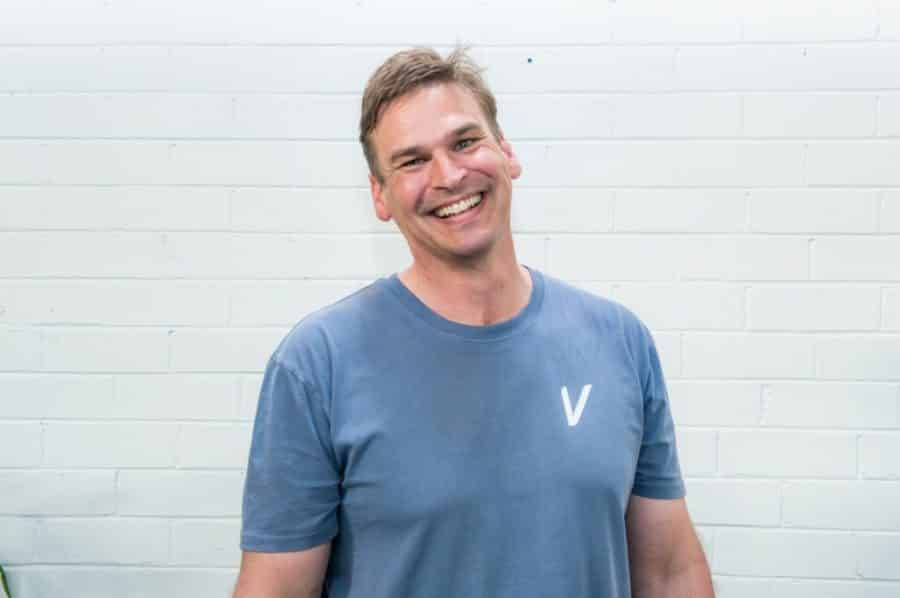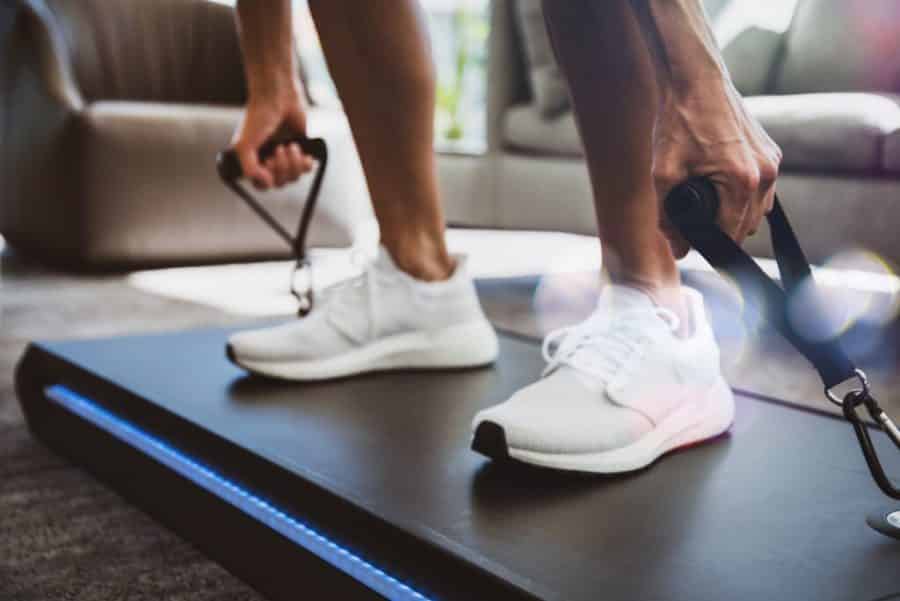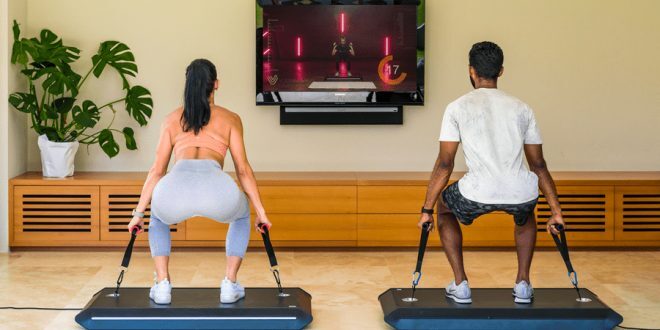“Connected fitness is just better – better, faster and more effective.”
Having carved out a successful career within economics as the head of a trading group, it’s no surprise that friends and family of Perth entrepreneur Jon Gregory were surprised when he made the decision to branch out into the connected fitness industry.
Five years on, however, millions will be glad that he did!

Jon had always had a passion for fitness, having even used weights in his downtime during long days at the office. However, he had always felt as though home resistance training – even resistance training in general – could be improved in some way. Was there a way to make training more engaging, more interactive and overall more effective?
With an idea in mind, Jon set about creating a whole new connected fitness system, building prototypes himself using his vast physics knowledge. Initial impressions were positive, and before long, he was ready to launch the Vitruvian V-Form Trainer – an engaging, personalised resistance training system that works with the user to deliver the best results possible!
Since its launch in 2018, Vitruvian has gone from strength-to-strength, delighting thousands of users who are using the V-Form to explore the possibilities of resistance training – some for the first time ever! At the core of the operation is Jon and his passion for creating the best product that he can, working tirelessly to improve the system, build their research and provide customers with a home fitness experience that goes far beyond their expectations.
DDW spoke to Jon as he took time out from a busy day at Vitruvian HQ, covering the limitless opportunities within connected fitness, the accessibility that the V-Form offers to gym-sceptics everywhere and where the Vitruvian brand will be heading next…
DDW: The Vitruvian V-Form system seems to be making waves across Australia – and it’s picking up traction across the rest of the globe, too! Is this your first business venture within the fitness industry?
Jon: Within the fitness industry, yes. I’m a pretty old guy now – forty-six, which is embarrassing to admit! I have a degree in applied physics from Western Australia and spent my career in quantitative trading, working for banks and hedge funds, then I started my own trading group, doing algorithmic trading back before it was really a thing. I did pretty well out of it and made enough money to kind of to sit around and think about what I wanted to do next!
In the trading room, we had a set of weights that we’d use when the markets were quiet – that was the genesis of the V-Form. I was just thinking ‘Surely there’s a better way. We could use a bit of applied physics, some algorithms and some computer science to make some equipment that’s effective, engaging and full of data.’
It started with a lot of tinkering, trying to figure it out, then showing it to a few people – that went well! So, we kept doing prototypes and then founded the company in 2018 to try to bring the product to the world. That’s what we’re doing now.
DDW: It certainly seems to be going well.
Jon: Thanks! In the thick of it, you sometimes wonder, you know. In general, I think that we’ve made a product that people love – you can’t ask for much more than that in product development. If you can achieve that, you can sleep well at night.
DDW: Looking at your site, I notice that the product was developed in collaboration with ‘world-leading experts in health science, exercise research and professional training’. How long was the development process for the V-Form Trainer? What was that like?
Jon: Well, it’s kind of ongoing – we’ll probably never stop. It’s been amazing, really. Four or five years ago, I just thought we were making a fun bit of engaging equipment. I had no idea that it would be actually really effective and efficient.
I definitely had no idea that sports scientists would be interested in it – but they ended up coming to us. We had people saying ‘Wow, this is fantastic! We can train in new ways!’ Now that it’s electronic, the sky’s the limit. It’s been a great journey of discovery and finding not just something that looks good, but something is actually truly beneficial and cutting your ground and how you can train effectively. That’s amazing.
DDW: And it’s an ongoing process?

Jon: I’d say so. We don’t know where it’ll go, but it’s an exciting thing being able to to work on something that’s potentially going to bring new and more effective ways to train to the world – and so you don’t have to set up at a gym for two hours if you want to work on your muscle tone. With this, if you want to work on your muscle tone at home, you can! If you do it right and do it scientifically, you might be able to do it much faster and more effectively – and who doesn’t want that?
DDW: I think we can all agree on that! What were initial user reactions like when you first unveiled the product?
Jon: The first reactions were like ‘What the hell are you doing?’ It was friends and family who didn’t really know what I was going on about or why I was tinkering away in the shed! I’d show them and they’d say ‘What are you doing making hardware? I thought you were a trader or an investor or something!’ That was the first reaction.
Then they use it and they’re like ‘That’s actually pretty cool!’
The first time someone uses it, they don’t know what to expect. They stand on it, grab the handles, feel some force going through the handles, feel it changing… it’s a surprising feeling. It feels a bit exciting. It feels like you’re you’ve got something powerful in your hands – you’re in control of it and you’re able to kind of adjust it through your movements. It’s an exciting experience – kind of like jumping into a Tesla for the first time!
It takes people a few times to get used to it and learn to engage with it, because there is a learning process. You’re adapting to the machine and the machine is adapting to you – but that’s part of the enjoyment of the product, interacting with a machine in a dynamic and memorable way. The longer people use it, the more they understand why it’s beneficial and why they’re able to work in different ways, and that’s when they’re like ‘This is fantastic!’
If we can get people to go from that initial positive reaction to a longer-term reaction of ‘This is a game-changer!’…well, what more can we ask for as product developers, you know?
DDW: It seems like something completely new to the world of home fitness!
Jon: Yeah, I think so! This kind of electronic resistance has been around for years in various forms and there are some competitors on the market, just with a different take on how to do it.
Our particular take on it is just to throw the kitchen sink at it! We say ‘Look, we’re not going to give you an electronic product that just pretends to be a dumbbell, we’re going to give you the works’. You might put off a few people who just want to lift 10 kilos and be done with it, but our feeling was to give the world something different and exciting – and people do tend to want to engage with that. It’s nice.
DDW: Would you say that anyone can use it?
Jon: Absolutely! I’d say that everyone should use it.
That’s really what drove me initially – the idea of a practical device that my whole family could use. Something I could put in the lounge and my wife could use it, I could use it, my 80-year-old mum can use it and my 10-year-old son could use it. I think everyone should be doing some sort of resistance training within their daily life – most people know that now, too. As you get older, you know that your muscles start to weaken and that you need to do something to stave that off. As for when you’re younger, well, if you want to look good at the beach, you’ve got to do the work! Of course, working on certain muscle groups will help your posture if you struggle with a bad back, too.
Essentially, everyone should probably be doing some resistance training to help themselves live a happy and pain-free life.
DDW: The system works alongside an app that all V-Form users have access to. How do the machine and the app work hand-in-hand to deliver the best results possible?
Jon: Well, we made a deliberate decision to not build too much screen technology into the equipment and to let people use their own devices for a few reasons.
Firstly, devices are now an extension of yourself, so using your device to connect to the machine is a pretty personal way to connect to a product. Your phone connects to the product via Bluetooth and data flows between them so that you can see the forces that you’re using, remotely control the machine and access content like classes and work-out plans. It’s a constantly evolving feature list that we will offer our customers.
One thing I’m really excited to release is a teams functionality, where you can be on a team with your friends, asynchronously sharing a workout, or you might want to join a team with a great Trainer, the sort that really knows their stuff. Technology is really good at bringing engagement and connectivity into the exercise world – the opportunities there are amazing. You can create something that you want to come back to again and again – not because you have to or because you feel guilty, but because you want to.
It’s something that technology does really well – enable those kinds of rich, new experiences. Combine that with exercise and we’ve got a lot to offer.
DDW: Definitely – especially at a time when technology is the only way that so many of us can connect with each other.
Jon: Exactly. Connected exercise is changing the world because it’s just much more effective, interesting and so much more beneficial. In ten years time, the landscape for how we all exercise is going to be very different.

DDW: Well, the connected fitness industry is projected to grow to a value of $5.96 billion by the end of 2025, which is obviously not so far off in the future…
Jon: I never really know what that means, you know? How do you define the size of an opportunity? When you put a number on it, you’re talking about sales, capitalisation of companies involved, units… I tend to think more in terms of actual individuals or actual pieces of hardware out in the world. I think the scope is in the tens of millions of units, and that’s not even thinking very big! I mean, it’s huge from where we are currently, but it’s not so big as a projection.
Peloton, for example, had something like three million bikes – although, it’s probably a lot more than that now – and that’s a drop in the ocean compared to how many consumers are out there. They could have 30 million bikes and I’d like to think that we should be looking at those types of numbers, too. That’s how I think how big I think the market is. We’re just going to try our best to play as hard and as fast as we can.
DDW: It’s a market that’s grown hugely in such a short space of time. What do you think it is that makes connected fitness this popular with so many people?
Jon: Fundamentally, it’s just better. It’s better and it’s typical tech disruption. I mean, why has everyone got a mobile phone now instead of using a landline? It’s just better! Connected fitness is just a pretty standard play on the tech disruption dynamic – better, cheaper, faster.
DDW: So, with the idea of tech disruption – specifically that example of landlines and mobile phones – in mind, do you think that connected fitness like the V-Form Trainer could potentially surpass the popularity of traditional gyms in the future?
Jon: Gyms will always be with us and we’re just not about replacing or attacking gyms. We want to engage with the industry as it stands now and we’d love to have our equipment in gyms, too. We just want to meet people with our equipment, wherever they like to train.
What I do think we’re able to do – that gyms struggle to do – is reach a whole bunch of people who are currently very hard to reach. You know, there’s plenty of people who really want to train, but don’t know how. There’s lots of other roadblocks that people have, too, like thinking ‘I’m a bit too self-conscious to work out in front of others’ or ‘I don’t want to sweat in front of people’, all these kind of things that are really strong emotions that block people from doing what they feel like they should do. In resistance training, there’s a learnt component to it, too, so if you’ve never done a squat or deadlift or bench press before and you’re too embarrassed to go to a gym and have a person trying to show you, you’re a bit stuck.
Still, we think gyms will always be there because a whole bunch of people go to gyms for very good reasons – we’re not stopping or changing that.
DDW: So, your product just makes resistance training a little more accessible to those who wouldn’t go to a gym?
Jon: Yeah, I think so. We’re giving people options.
Even if you do go to a gym, you might not be able to make it to the gym all the time, so you might want a device that allows you to work out at home, or maybe you’ll share it with your kids or your wife in a new and different way. I think people go to the gym for a whole bunch of complex reasons that we don’t see us replacing them. We see us being an add-on or and opening up to the new demographics as well – and that’s really exciting.
DDW: So, personalisation is a huge part of this product as well. You’ve mentioned previously that the V-Form takes ‘an algorithmic approach to training’. What impact do you think that personalisation has on the quality of resistance training overall?
Jon: It just means that you can be training so much more effectively, because one of the huge challenges in traditional weight training is selecting the right weight. Typically, you’ll select a certain weight so that you can do 10 repetitions of that particular weight, but the right weight for you can vary depending on what you’ve eaten, how you’re feeling… it’s only ever a guess.
Once weights are in software, you can change them 50 times a second, selecting the right weight at every single point in your range of motion, both up and down and across your ten repetitions. It just means that you can be hitting the musculature with complete accuracy instead of just this massive amount of guesswork.

DDW: So, it’s quite cutting-edge technology really…
Jon: It is and it isn’t! I mean, it’s robotics and motion control, which have been around forever – but now we’re applying it to resistance training. We’re still figuring things out and working out the most effective way to do it, but we’ve got the tools.
I’m really excited about how rich and how deep it’s going to get, because if we have thousands and thousands of people using our equipment, working in different ways, we’re going to have the power to learn from our community what the most effective way to train is – time, intensity, volume. We’re going to be able to do amazing cloud-based research and then feed that straight back into our community. That really gets my inner physics nerd! I can’t wait to do that. What a great thing to be able to offer our customers. That’s really cool.
DDW: It sounds like the possibilities for Vitruvian are huge. What do you think sets the V-Form apart from other similar systems on the market?
Jon: All I can say is ‘We are what we are and this is what drives us. This is what we’re doing, this is the gear that we’ve got. I hope you like it here – come and use it and I’m pretty sure you’ll see the benefit’. Are we better than everyone else? Well, obviously, I like to think so!
When it comes down to it, though, we’re just going to go and do what we think needs to be done, as will our competitors. Ultimately, we’ll all be judged by how well we treat our customers and how much we put them at the centre of the business. That’s certainly the business we’re building.
DDW: So, what’s next for Vitruvian?
Jon: Just a lot of work to do in rolling out the network! I mean, that’s how I see the business now – we’ve got the product, now we need to keep building the software, keep adding features, keep creating content. Just running as hard and as fast as we can!
So, yes, nothing really ‘next’ – just a continuation of the madness!
To find out more about Vitruvian and the V-Form Trainer, head to the Vitruvian website.
See Also: Interview With The Nomad Collection


